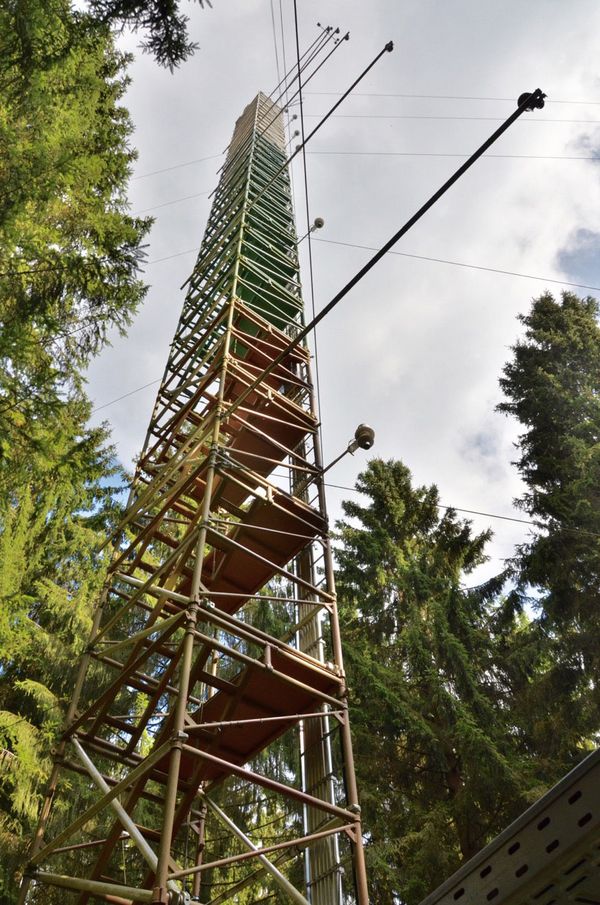Wüstebach

The research center Juelich (IBG3: Agrosphere) currently operates 6 climate/eddy covariance stations within the TERENO observatory “Eifel/Lower Rhine Valley”. Three of these stations (Selhausen, Rollesbroich and Wüstebach) are part of the ICOS infrastructure.
The Wüstebach study site is located in the German low mountain range within the borders of the Eifel National Park near the German-Belgian border. The site covers the area (38.5 ha) of the small catchment of the Wüstebach, with altitudes ranging from 595 to 628 m a.s.l.. It represents the typical, but not natural, spruce forest vegetation type of the region with Norway Spruce (Picea abis L.) as prevailing tree species.
The mean annual precipitation at the test site is 1220 mm for the period 1979 to 1999. The geological subsurface is built up by fractioned Devonian shales with occasional sandstone inclusions, covered by a periglacial solifluction layer of about 1–2 m thickness. In the valley Gleysols and Histosols (half-bogs) have formed under the influence of groundwater, while hillslopes are dominated by Cambisols and Planosols.
During late summer/early autumn of 2013, trees were almost completely removed in an area of 9 ha by the national park forest management in order to promote the natural regeneration of near-natural deciduous forest from spruce monoculture forest. Strong effects are expected on soil, water quality, exchange processes and composition of flora and fauna due to the imposed disturbance that will provide a unique insight into the recovery and regeneration of forest systems.
In order to monitor the matter and energy balance changes associated with the partial clear-felling, various continuously logging instruments were installed in the catchment, starting from 2008. The measurement infrastructure now comprises among others several weather stations, a flume, weighable lysimeters, cosmic-ray soil moisture sensors, and a wireless soil sensor network (Graf et al., 2014; Bogena et al., 2015). The most outstanding installation is the 38 m high eddy covariance tower (50.504°N, 6.331°E, 610 m a.s.l.) that was set up in a still forested eastern part of the study site. The measurements that started in 2009 include fluxes of matter, energy and momentum, profiles of temperature, humidity and radiation and much more. Currently the tower is equipped with a CSAT3 anemometer and a LI7500 gas analyser, a CO2 profile with a closed path gas analyser is in the planning stage. By using tower measurements of latent heat flux in combination with runoff, precipitation and soil moisture measurements, a good closure of the pre-clear-felling catchment was achieved.
Immediately after clear-felling a second small eddy covariance tower (50.503°N, 6.335°E, 667 m a.s.l.) was installed at the newly created forest clearing to observe its exchange processes especially in comparison with the tower measurements.
Regularly updated data of the site can be achieved at following address:
teodoor.icg.kfa-juelich.de/ibg3searchportal/index.jsp
Publications that refer to the Wüstebach study site
Baatz R., H. Bogena, H.-J. Hendricks Franssen, J.A. Huisman, C. Montzka and H. Vereecken (2015). Development of an empirical vegetation correction for soil water content quantification using cosmic-ray probes. Water Resour. Res., 51, DOI: 10.1002/2014WR016443
Bogena, H.R., R. Bol, N. Borchard, N. Brüggemann, B. Diekkrüger, C. Drüe, J. Groh, N. Gottselig, S.J. Huisman, A. Lücke, A. Missong, B. Neuwirth, T. Pütz, M. Schmidt, M. Stockinger, W. Tappe, L. Weihermüller, I. Wiekenkamp and H. Vereecken (2015): A terrestrial observatory approach for the integrated investigation of the effects of deforestation on water, energy, and matter fluxes. Science China: Earth Sciences 58(1): 61-75, doi: 10.1007/s11430-014-4911-7.
Bogena, H.R., J.A. Huisman, R. Baatz, R., H.-J. Hendricks Franssen and H. Vereecken (2013): Accuracy of the cosmic-ray soil water content probe in humid forest ecosystems: The worst case scenario. Water Resour. Res., 49 (9): 5778-5791, DOI: 10.1002/wrcr.20463.
Cornelissen, T., B. Diekkrueger and H. Bogena (2013): Using HydroGeoSphere in a forested catchment: How does spatial resolution influence the simulation of spatio-temporal soil moisture variability? Procedia Environmental Sciences, 19: 198-207, doi: 10.1016/j.proenv.2013.06.022.
Fang, Z., H.R. Bogena, S. Kollet, J. Koch and H. Vereecken (2015): Spatio-temporal validation of long-term 3D hydrological simulations of a forested catchment using empirical orthogonal functions and wavelet coherence analysis. J. Hydrol., doi:10.1016/j.jhydrol.2015.08.011.
Graf, A., H. R. Bogena, C. Drüe, H. Hardelauf, T. Pütz, G. Heinemann, Vereecken, H., 2014: Spatiotemporal relations between water budget components and soil water content in a forested tributary catchment, Water Resour. Res., 50, 4837–4857, doi.org/doi:10.1002/2013WR014516.
Qu, W., H.R. Bogena., J.A. Huisman, J. Vanderborght, M. Schuh, E. Priesack and H. Vereecken (2015): Predicting sub-grid variability of soil water content from basic soil information. Geophys. Res.Lett. 42: 789–796, doi:10.1002/2014GL062496.
Stockinger, M., H. Bogena, A. Lücke, B. Diekkrüger, M. Weiler and H. Vereecken (2014): Seasonal Soil Moisture Patterns Control Transit Time Distributions in a Forested Headwater Catchment. Water Resour. Res., 50, doi:10.1002/2013WR014815.
Stockinger, M.P., A. Lücke, J.J. McDonnell, B. Diekkrüger, H. Vereecken and H.R. Bogena (2015): Interception effects on stable isotope driven streamwater transit time estimates. Geophys. Res. Lett., 42: 5299–5308, doi:10.1002/ 2015GL064622.
Rosenbaum, U., H.R. Bogena, M. Herbst, J.A. Huisman, T.J. Peterson, A. Weuthen, A. Western and Vereecken, H. (2012): Seasonal and event dynamics of spatial soil moisture patterns at the small catchment scale. Water Resour. Res., 48(10), W10544, doi:10.1029/2011WR011518.
Bogena, H.R., M. Herbst, J.A. Huisman, U. Rosenbaum, A. Weuthen and H. Vereecken (2010): Potential of wireless sensor networks for measuring soil water content variability. Vadose Zone J., 9 (4): 1002-1013, doi:10.2136/vzj2009.0173.
